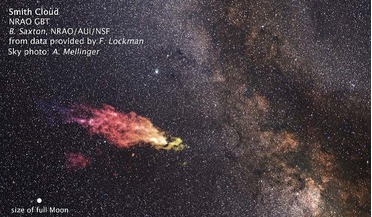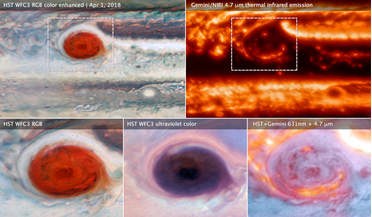 19 July 2016
Gravity waves on Venus create 'fountain of Aphrodite'
19 July 2016
Gravity waves on Venus create 'fountain of Aphrodite'
... an upwards motion in Venus' atmosphere that carries ultraviolet-dark material and water-rich air to the surface of the cloud layer, creating both the observed 'fountain' and an extended downwind plume of vapour. "We've known for decades that Venus...
 01 February 2016
Enormous gas cloud on a collision course with the Milky Way
01 February 2016
Enormous gas cloud on a collision course with the Milky Way
... through the cloud, yielding clues to the chemical composition of the cloud. Combined ultraviolet and radio observations correlate to the cloud's infall velocities, providing solid evidence that the spectral features link to the cloud's dynamics...
 29 October 2018
A rare discovery helps scientists measure a key process in star formation
29 October 2018
A rare discovery helps scientists measure a key process in star formation
...a structure has been seen in a molecular cloud. And, after reconstructing the chemical state and the evolutionary history of the cloud, the team, whose lead author on the research paper is Pei Zuo from the Chinese Academy of Sciences in Beijing, have...
 26 April 2016
Sulphur chemistry could be the key to clouds on many exoplanets
26 April 2016
Sulphur chemistry could be the key to clouds on many exoplanets
... patchy ones, are present in its cool atmosphere. However for an object as cool as 700 K, the origin of the cloud coverage has been somewhat puzzling to scientists. 51 Eri b orbits 51 Eridani, a pre-main-sequence F dwarf that is only 20 ...
 30 June 2021
Life as we know it is not possible in Venus' clouds, new study says
30 June 2021
Life as we know it is not possible in Venus' clouds, new study says
... – a gas that on Earth can only be produced artificially in a lab – in the clouds of Venus. Since then studies have either overturned the claim or added further intrigue to the finding. But now, a new study measuring water concentration in Venus...
 11 May 2020
Spacecraft and telescopes join forces to probe deep into Jupiter's atmosphere
11 May 2020
Spacecraft and telescopes join forces to probe deep into Jupiter's atmosphere
... radio waves that can penetrate through the thick cloud layers. The data from Hubble and Gemini can tell us how thick the clouds are and how deep we are seeing into the clouds," Simon explained. By mapping lightning flashes detected...